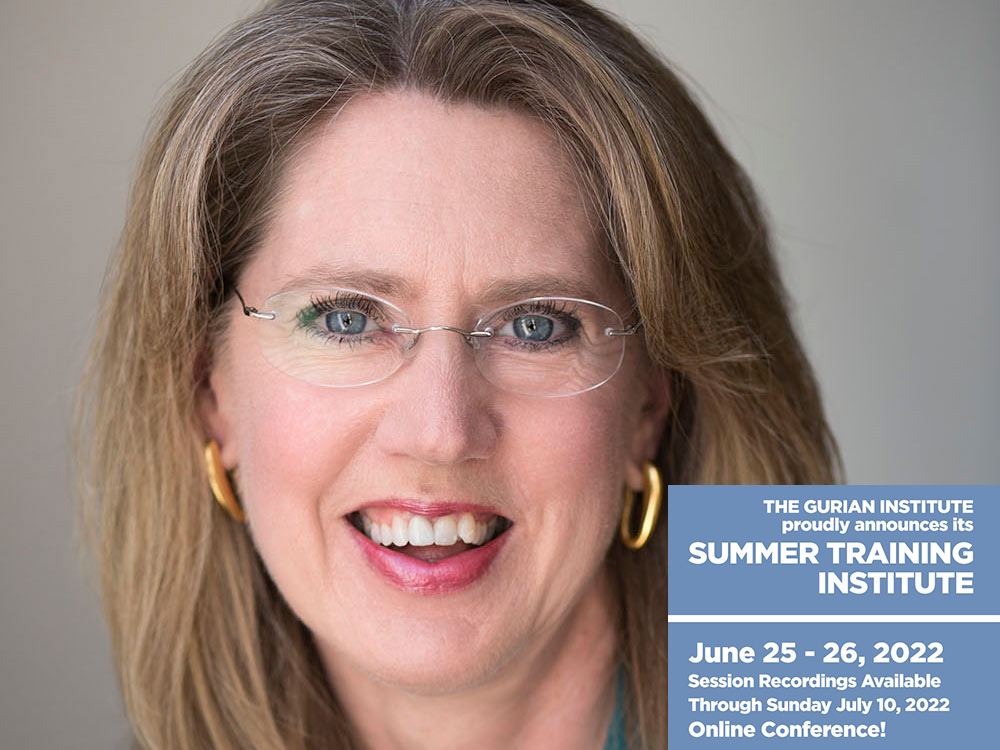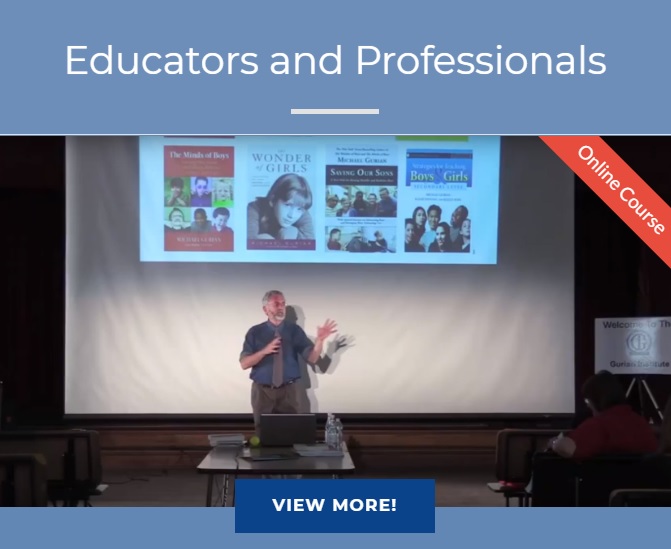Our guest blog this week comes from Eva Dwight, Gurian Institute Program Director. A teacher and counselor, Eva spearheads our Head Start Pilots in Phoenix and travels the country providing training for K-12 schools. She is also a Positive Discipline Certified Trainer.
Eva will speak on these topics at the Gurian Summer Training Institute in the last week of June. She also leads our Trainer Certification program, which transpires on Monday morning after the weekend event. To learn more about our Summer Training and to register, please visit: https://gurianinstitute.com/events/gurian-summer-institute-2022/.
Throughout my 20 years as a junior high counselor, I was continually dismayed to see that the majority of students who were failing classes and experiencing discipline problems were boys. I worked diligently with teachers, parents and administrators to help many of these students turn things around, but we were always coming at it from the “reactive end.” I knew there must be more that we could’ve been doing on the “proactive end,” but it’s hard to make strategic changes when you don’t understand the cause of the problem.
By the time I found Dr. Gurian’s book Boys and Girls Learn Differently, I was one year from retirement. When I started reading about how brain anatomy and function impact boys’ and girls’ learning needs, social interaction patterns and emotional processing, I was jumping up and down with excitement! THIS was what I’d been looking for! THESE were the answers we needed! If only I’d discovered it 20 years ago…but better late than never, right?
Three years after retiring from public school life, I’m still excited because I’ve been able to step into this work with Dr. Gurian, helping educators understand how to use brain science to inform teaching. You may already be using a lot of these strategies because you figured out along the way that they work. Knowing that they also align with brain science will, hopefully, be validating and encourage you to continue to use them because they are actually “best practice.”
Incorporate Movement into Daily Lessons
Remember: If the bum is numb, the brain is the same! When I first started teaching, I was a little baffled about why most of my 12-year-olds weren’t interested in sitting still for 55 minutes, reading, talking and writing about great stories. I’m high on the “female brain” end of the spectrum so sitting and talking is one of my favorite things to do. And I love to read and write! So my lessons were highly verbal and designed for kids who were…um…like me. That was a relatively small percentage and included very few boys.
Gradually, I figured out that if I broke lessons up into 15-20 minute chunks and included some opportunities for movement, my students were better behaved, we were all having more fun, and they were actually learning more!
A good rule of thumb is to expect kids to sit quietly and focus one minute for every year of age. For instance, we should incorporate some form of movement about every six minutes for a 6-year-old, every 12-15 minutes for a 12-year-old, etc. (Faculty meetings and professional development training: get people moving every 30 minutes…and bring donuts!)
Opportunities to move can be subtle. As a counselor, I loved going to one particular school (with a Gurian-trained principal!) to enroll 6th graders for junior high every spring because they had THE best-behaved students–and not a single one was sitting in a chair! Several were working at standing desks, and others were sitting on large exercise balls that allowed them to bounce gently as they worked. Clipboards were available if they wanted to park themselves on the floor, instead.
If your budget is limited, provide students with stress balls (and guidelines for appropriate use) to squeeze in their non-dominant hand; tape Velcro to desks so students can stroke it; or tie an exercise band across the front legs of a chair so students can bounce their legs against it.
Be sure to include whole-class brain breaks or content-related games that allow kids to move around the room and really get their blood pumping…more on that soon!
Think: Visual Before Verbal
Moving through the queue for the Pandora Flight of Passage at Disney World’s Animal Kingdom, my husband and I had an opportunity to conduct what Dr. Gurian calls “citizen science”: noticing how the brain science plays out in real life experiences. My husband keyed in on a little boy in the queue, probably about age 7, asking his dad the occasional nervous question about what the ride would be like. Key noticing: he didn’t say much. He was feeling, but not necessarily expressing.
After the ride, which takes you on a virtual flying tour of Pandora, that child couldn’t stop talking! All the way through the exit queue, we were treated to his excited description of every detail, how he felt when that dragon thing jumped out at him, the thrill of diving over that cliff toward the sea…not only was he talking, he was expressing emotion as he described his experience using a lots of detail! We giggled as we parted ways, my husband remarking, “Give a boy some visual stimulation and suddenly he has a lot to say!”
Of course, I’m not going to encourage you to put your students into virtual reality headsets (in fact, we want to be very careful about the amount of time we put kids in front of screens)! But how many of you have asked students to write about an experience—especially anything that requires sensory or emotional content—and gotten blank stares or off-task behavior, particularly from your boys, in response? Even writing a report or an essay taking a position on a topic can be more challenging because boys typically have less access to their verbal and emotional centers than girls.
Think of it as having a crayon box with lots of different colors representing a variety of sensory and emotive information. Many students might come with a box of 64, complete with the crayon sharpener, while others may have an 8 pack. We need to “fill the sensory box” before having them write.
How to do that? I LOVE brainstorming around this topic because there are so many creative things we can do! For instance…
Have students build something…play a game…act something out…draw a picture…FIRST! This will stimulate more activity in various brain regions, including the ones that process words and emotions, so they have something more concrete to talk or write about.
For younger students, remember that TELLING is a preliminary step to WRITING. If you can get children who aren’t writing yet involved in an activity and engage them in conversation about it, you can help them make connections between what they did and what they learned from it so they’re developing those reasoning/analytical skills!
Stimulating STEM Thinking…in ALL subject areas!
This is an important extension of thinking visual before verbal. Careers in STEM areas involve a lot of thinking that happens in the visual/spatial/mechanical centers of the brain. This tends to be a more natural strength for boys, so playing to their strengths can be helpful in engaging their interest. Many girls have natural inclinations in this area, too, but if we don’t stimulate their brains with activities that require this type of thinking throughout the early years of preschool and elementary school, we’ll continue to experience lower numbers of females in STEM electives at the secondary level, and we’ll likely continue seeing fewer women than men entering STEM careers.
Whether students’ natural strengths lie in the verbal or the nonverbal domain, helping them develop a “well-rounded brain” can be the goal of every teacher, regardless of the content you teach.
As you examine your lessons for brain-balanced activities, watch for opportunities to have students:
- build something in 3 dimensions or take something apart
- read and interpret maps, graphs, diagrams, blueprints, etc.
- draw/create in 2 dimensions
- do something physical as part of the learning process
- create a process or a flowchart, program robots, etc.
Any of these activities can stand alone as a learning assessment, or provide a springboard for writing. Ask them to reflect on the process they used, what worked/didn’t work, what they struggled with/what was easy, how they feel about the outcome, etc. Moving from activity-based learning into verbal processing ensures that we’re engaging students more in whole-brain experiences.
Strategic Help AND Strategic NON-Help!
As I’ve said, I fall pretty heavily on the “female brain” end of the spectrum. My mirror neurons fire when I sense a student’s frustration and they keep firing, often putting me on empathy overload! I’m very quick to jump in and help so that in alleviating the student’s frustration, I lessen my own discomfort. Unfortunately, I can easily cross the line into overhelping. Students need to experience a certain level of frustration as part of the learning process. Pushing through that builds resilience, self-confidence and independence. If you’re like me, this strategy can help you put some structure to the struggle, so to speak, so that you help kids…but in a way that grows skills instead of dependence on you.
- Ask students to learn by JUST WATCHING and then try an activity themselves. Use as few words as possible in your demonstration, to encourage them to pay attention to the visual aspect of what you do and strengthen their observation skills.
- Request that they work to figure things out without your help for a certain period of time and be ready to show you what they’ve tried before you’ll step in.
Sometimes, you might encourage kids to work individually so they learn to rely on themselves, growing their independence and self-confidence as learners. Other times, you can ask them to work with a group and after they’ve exhausted their ideas, come to you for assistance. You can also create a tier-based structure: first, I try it myself. Then I ask other students. Then WE ask the teacher if we still need help!
Side note: It’s wise to inform students AND parents in advance of what you’re doing and why, so you don’t inadvertently convey the perception that “my teacher won’t help me.”
Competition in the Classroom
In the wise words of Mary Poppins: “In every job that must be done, there is an element of fun. You find the fun and—SNAP!—the job’s a game!” Remember my chagrin as a first-year teacher at realizing that kids didn’t want to sit still and read and write all hour? Working games into my lessons helped me break out of my comfort zone and provided opportunities for my students and me to build relationship through challenge, laughter and fun. They learned more of the content I was trying to teach them, and if you look beyond the obvious, they also got to practice a lot of important social-emotional skills, including:
self-promotion
assertiveness
leadership
“followship”
not taking loss personally because “You win some—you lose some.”
problem solving and strategizing for greater success “next time”
teamwork
verbal and nonverbal communication
Many boys, whose testosterone naturally pushes them toward moving up in the social hierarchy by winning a game, will immediately gravitate to competition. Lots of girls are naturally competitive, too. So we’re playing to their strengths and we’ve already got their buy-in.
You’ll also recognize those kids who don’t particularly like competition, so they’ll need encouragement and possibly some behind-the-scenes work on your part to make sure they feel emotionally safe during games. (This could include picking teams yourself or assigning team roles so that dominant personalities don’t inadvertently squish the learning out of the experience for reluctant players.)
Again, we want to grow “well-rounded” brains, and it’s natural for kids (and adults) to set themselves up for success by only engaging in the kind of learning that their brains are strongly wired for. We can be sensitive to this, AND it’s important to stretch kids beyond their comfort zone. Working through the discomfort of mastering a difficult concept or trying a new type of activity builds resilience, and sometimes even sparks interest where there was none before.
Because there are so many ways to engage in competition, you can mix it up to meet the needs of different learning styles and your content goals:
Whole class competition: Beat the clock! How quickly (and effectively) can we…?
Small group: board games and card games, altered for class content
Individualized: Beat your last result! This one is good for math facts and other tests of memory, or it can be used for retaking tests to achieve a higher score.
Wrapping Up and Moving Forward
If you’re saying right now, “Hey! I already do some (or A LOT) of this stuff!”–good for you!
If many of these ideas are new for you, I’d like to encourage you to start using them, even in small increments, as you increase your comfort level. Gurian Institute research has demonstrated that they can
- improve teacher effectiveness
- close achievement gaps, especially in literacy, math, and science
- close gender gaps across the curriculum
- significantly decrease discipline referrals
- significantly improve student behavior – as teachers deploy the GI Strategies, students change the way they operate in the classroom.
I’d also like to encourage you to share with your students (and their parents) what you’re learning about brain science and how you’re using it to inform your teaching. In fact, include them in that creative process whenever possible and collect data together on what types of activities help them learn best! Together, all of you can become “citizen scientists” in the classroom.
Eva will speak on this topic at our Summer Training Institute. To learn more about this event and to register, please visit: https://gurianinstitute.com/events/gurian-summer-institute-2022/.










